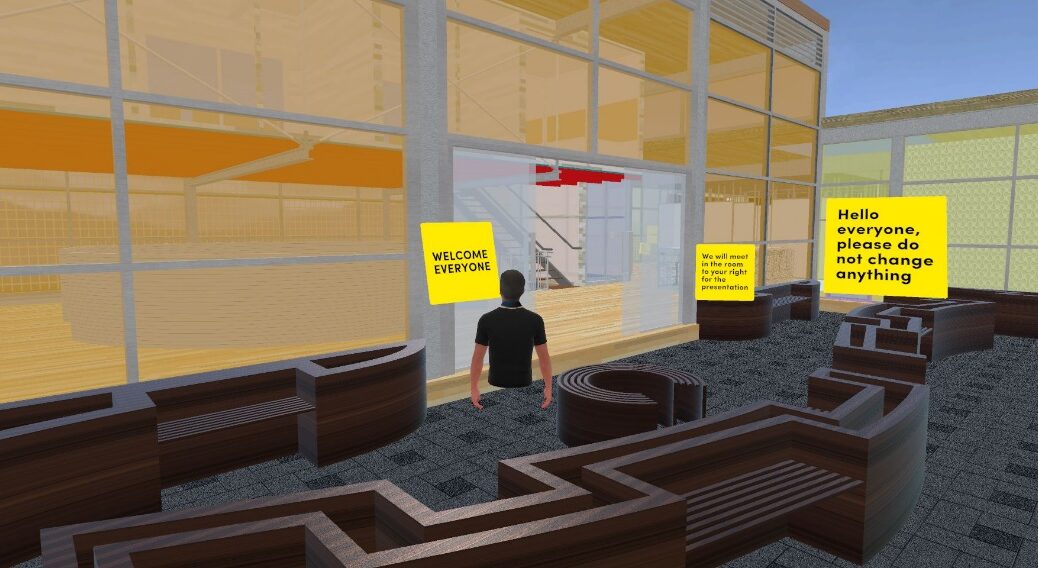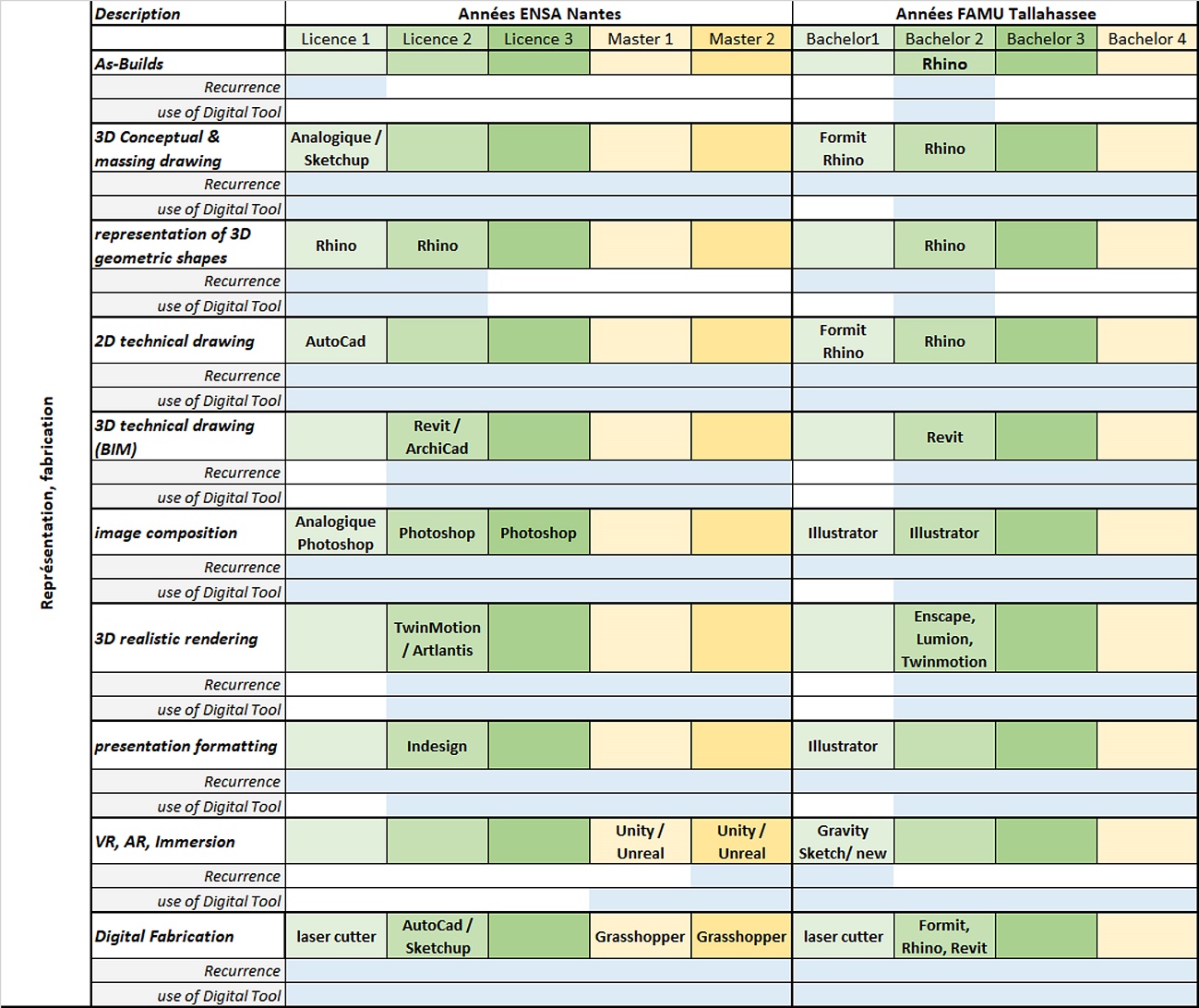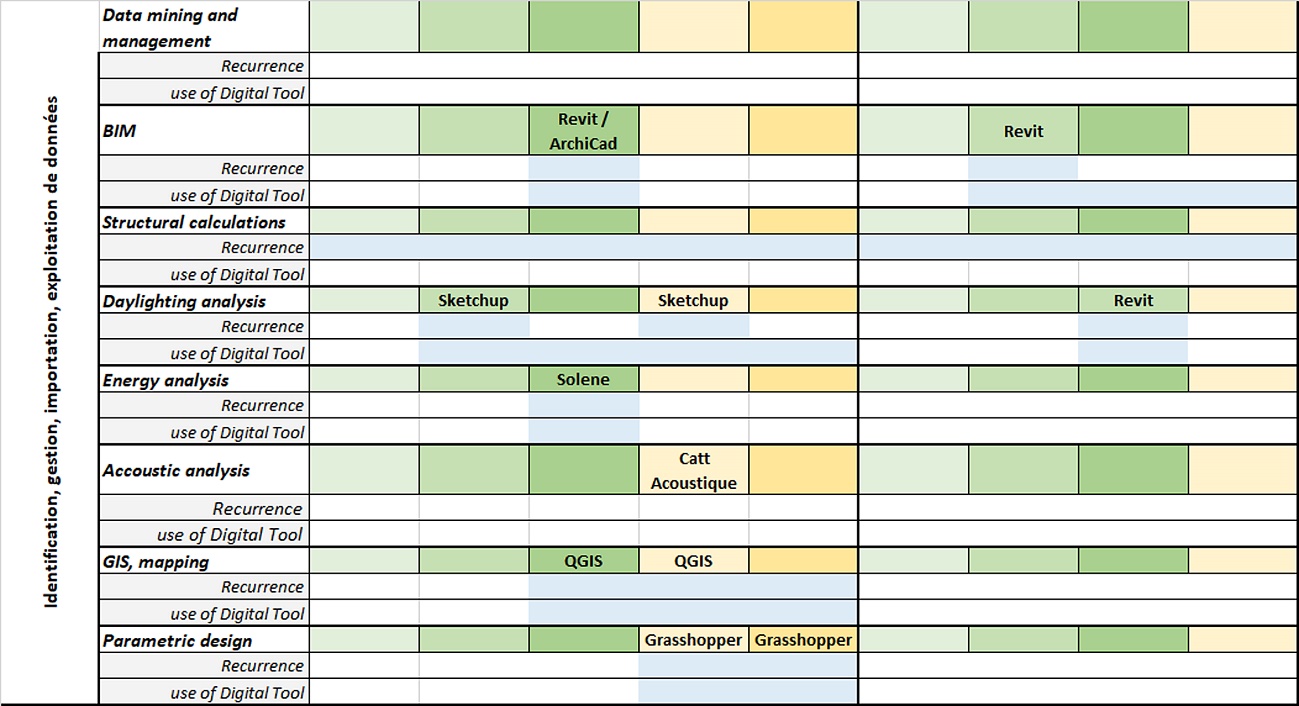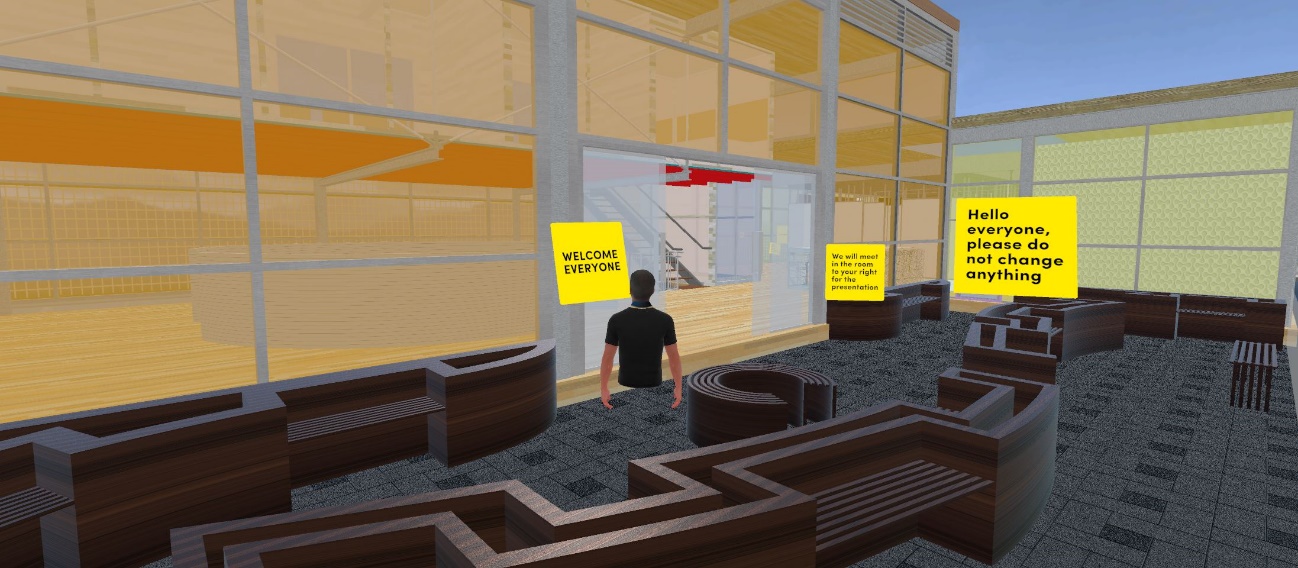This article was originaly written for a book that will now hardly be published due to several reasons. The text hold by Laurent Lescop, Hadas Sopher (1), Olivier Chamel (2) and Bernd Dalgrün (3) describes the very pionneer experience of Immersive Learning using Metaverses during the covid pandemia. This has been a fondation for what we do now and it would have been sad to hide it on the folder of forgotten works.
- ENSA Nantes AAU-CRENAU, UMR-CNRS 1563 – Nantes, France
- FAMU, Tallahassee, Florida, USA
- HCU, Hamburg, Germany
Augmented Design: searching for a new pedagogical design paradigm
Introduction
Pencil or mouse? The question of the place of digital technology in pedagogy is one that we like to avoid. The tools being omnipresent, their legitimacy no longer seems to be a subject of discussion and at the same time, the complexity of mastering them at a higher level excludes non-experts from a relevant evaluation.
It is therefore necessary to change the axis of analysis. We don’t focus on digital technologies for pedagogy through its technical aspects but rather how digital technology creates complexity and indicators on how the project is taught to students. In the workflow that goes from the brief to the built project, the use of digital tools appears as an indicator of complexity that we will find in the generation of forms, the use of materials, and the use of environmental studies or the taking into account of a set of political or social contextual data.
We call Design Paradigm [1] models and archetypes of problem-solving solutions. It means that a paradigmatic design is a process and a set of solutions that are considered by the community as effective and successful. In architecture, as in many industries, design paradigm refers to specific workflow to identify and describe design solutions. This workflow uses a process of abstraction and categorisation. Digital tools are generally tailored to follow the workflow up to the point where they suggest a specific process to follow as we saw with BIM. Therefore, are new concepts like generative design changing the design paradigm?
The question is then: is there really a paradigm shift, and if so, at what point does it happen? Often criticized, computer aided design (CAD) software do not enable architects to design the way it has been done for centuries [2]. AutoCAD does not transform the way of thinking and drawing architecture. Parametric design, owes much to D’Arcy Thomson and his book On Growth and Form, first published in 1917. Parametric design succeeds in transforming design thinking and workflow by integrating a greater number of input parameters and a significant level of complexity during early design stages [3].
In the past two decades, two paradigm shifts took place in the world of architecture that have greatly disrupted the organization of companies: the first is the computerization and the second is BIM, which emerged ten years later. Artificial Intelligence, a new and even more radical shift is on the horizon, holding promise to enable the automated production of design tasks. Autodesk for instance advertises on Generative design and the way it’ll change the design process.
By putting in a dialectic form the question of pencil or mouse, the aim is to evaluate the anticipation or resistance that design pedagogy faces in front of digital tools. We aim to understand when and in what form digital concepts and tools can be integrated in the curriculum of architecture education programs. For this purpose, we will draw on the individual and joint experiences of a course involving three schools of architecture, ENSA Nantes in France, FAMU in Tallahassee, Florida US, and HCU Hamburg in Germany.
The origin
Architecture was originally taught at the atelier, through a master and apprentice learning method. Following this approach, the pedagogical approach in the Ecole des Beaux Arts followed the traditional rules of classicism and used precedents as a learning source [4]. Sessions followed the atelier format, with expert tutors critiquing the students’ projects [5] [6]. According to Knoll [7], this method laid the groundwork for the project-based teaching approach that is still used today. The Bauhaus school presented an alternative approach, emphasizing experimentation and novelty by including crafts activities in the curriculum, together with a distinctive social agenda, all within an apprenticeship model [6].
Relaying on the Beaux Arts atelier model and the Bauhaus tradition for experimentation and novelty, design education methods have largely remained unchanged for a century. Thoroughly described by Professor Donald Schön [8] [9] [10] design is a practicum of reflective epistemological activities. Schön outlines the teaching methods referring to active tutor’s demonstration and active learning through listening and imitating the tutor. Jones [11] describes the components of design activities and procedures applied to create design progress. Salama [12] describes the teaching methods based upon these principles.
Inter-university cooperation, the challenges of digital technology
As part of a proposal for a paper at the 2020 SCAN conference, we have conducted a comparative survey between FAMU and ENSA Nantes to analyse in our curriculum the role of digital tools in design pedagogy [14]. As our schools have similar resistance to the use of computers in the first years. The idea was to see which course was concerned, using which software and how learning was remobilized in the continuity of the curriculum. We also wanted to evaluate the use of VR immersion processes at the very early stage, first year, first semester given that the students’ video game culture is often well established and can be a good starting point to introduce architecture.
The tables of Figure 1 and 2 describe the techniques and software taught to support the paradigm of « classical » or « traditional » design process in FAMU and ENSA Nantes, These techniques and software are mainly seen in the Bachelor’s degree for the American system and are not updated in the Master’s degree. The techniques and software that introduce a rupture in the way the project is conceived are optional for students in the Master’s program. We classify in the techniques and software of rupture, the algorithmic approaches, the exploration of virtual worlds and the exploration of new materials.
This study has allowed us to set up a conceptual framework which is presented in the next section.
The concept of legacy/emergence
The differences revealed between the two schools seen in table 1 allowed us to outline a paradigmatic shift in educating students how in the design process, or to unfold the role digital technology plays in design pedagogy. Does it create new concepts? To do this, as previously stated, we have to stay away a few clichés, such as the one asserting that the software or devices are just « tools ». This is an obstacle that hinders the development of new postures in pedagogy and research, particularly with the advent of digital tools like VR. It is indeed like saying that the piano forte has not transformed the writing of music by rationalizing chromatic intervals or that photography did not change our relationship to pictures [15]. It is necessary, on the other hand, to locate what we above called points of rupture.
To do so, we need to distinguish tools and concepts, when examining VR tools. The concept of virtual reality is much older than one might think. It is generally attributed to Damien Broderick and popularized by Jaron Lanier. It is often recalled that the term appears in Antonin Artaud’s 1938 play, Le théâtre et son double. In fact, it is even much older, since we can find it as early as 1847, in Joseph Willm philosophical essay entitled Histoire de La Philosophie Allemande Depuis Kant Jusqu’à Hegel, volume II [16]. We could even go a step further and include in the corpus, Corneille’s L’Illustion Comique, which even if this 1635 play does not use the words virtual reality, it sets up a narrative device that becomes a scenic device picturing the interlocking of worlds that we recognize today as virtual reality. If digital technologies are recent, the body / spirit / place topic, which virtual reality seizes, accompanies many great philosophical themes since the origin. In the same way, the very typology of the most contemporary devices such as the CAVE [17] or the VR headsets have very ancient ancestors. Let’s look at the panoramas of the XIXth century or devices such as Edison’s Kinetoscope (1889), Dickson and Casler’s Mutoscope of (1894) or Lumière brothers’ Kinora (1895). If the technologies are very different and the performances incomparable, the fundamental questions are the same since it is of evaluating the effects of immersive illusion in an individual or a collective device.
Today digital immersion brings with what is sometimes called ergodic media [18] new issues for practice differs between immersion, described as the system’s components and capacity to provide a digital display that matches with the user’s movements, and presence, that refers to the user’s illusive experience of being in a place or a situation, as conveyed by the immersive system. This differentiation can support the understanding the role of VR in design pedagogy, as means to enhance the conceptualization of the design project, while also support the design of the educational setting. By providing users enhanced presence in a life-scale display of the design project, the project and educational space may merge and unfold, in a similar fashion to the way architecture was originally taught in the atelier, through a master and apprentice learning method. Previous studies demonstrate that the use of VR as educational means in the architecture studio enhances learners’ generation of new design issues [19], and supports the refinement of the design project [20]. Use of VR worlds to handle and identify architectural issues enabled learners to collaborate and learn under the atelier regardless of their physical location.
To help us clarify things and try to discern the points of rupture of digital tools, we can conceive a typology intending two types of narratives. The first type is what we can name the narrative of legacy. The narrative of legacy is understood as a protocol for transmitting content with a teleological aim, meaning with a purpose, which is that of preserving and maintaining rules and rites with the highest possible qualitative requirement. There is thus a transcendental objective. This narrative of legacy is what constitutes the framework of our academic institutions, our schools of architecture or even professional chambers such as the Chamber of Architects. The transmission is done through the setting up of symbols and rituals that are socially recognized as the affirmation of a moral and scientific authority and as a reservoir of references. The transmission of the inheritance story is done from one to another through in a series of interdependent phases. If in the scientific world, the content of the narrative evolves, often through the exhaustion of paradigms, the paths of its evolution are controlled by the teleological aim, namely the production of new knowledge validated by peers.
The narrative of emergence refers to a second typology in which an event seems to take place outside the narrative of legacy. In archaeology the discovery of Lascaux is a very good example by its exceptional content which exceeds and displaces all that the scientific and social world could know or imagine of prehistory. The narrative of emergence can be assimilated to a narrative of creation. What will characterize this narrative is a holistic experience, that is to say, a creative experience of multiple interactions with numerous domains. The narrative of emergence will thus weave correspondences with different points in history and above all, will question our present time in many fields. It is a historical emergence that shakes the present.
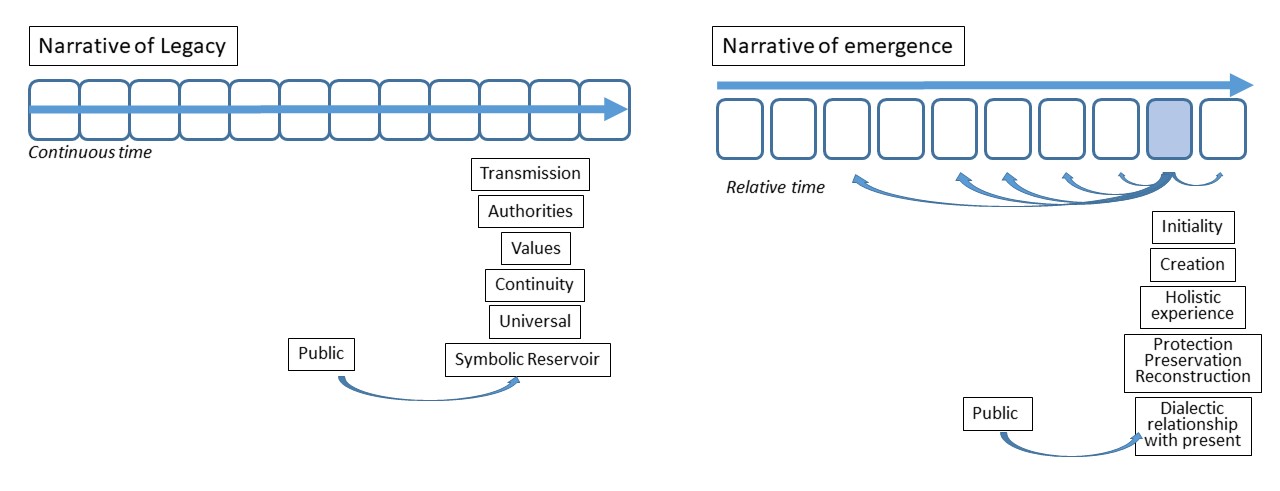 In the digital world linked to architecture, we can see the manifestations of these two narratives. The teaching of the project, for example, within the studio, wonderfully reproduces a narrative of legacy, even if the teaching and the projects are intended to be transgressive or contemporary. The distinction between process and production helps to clarify. While the production may produce renewed prototypes, the process may remain in a very standardized form inherited from peers. On the other hand, the irruption of generative approaches and then those accompanied by artificial intelligence produce fascinating narratives of emergence. Why generative rather than CAD or BIM? It is in the very course of the design process. On the one hand, we have problem solving that is done in succession, with each solution closing the range of questions and induced solutions. The progression is linear, even if there are feedbacks, it is also convergent. The method contains many implicit elements that we call experience or practice. On the other side we have the generative process which requires to make explicit the set of constraints in the form of input data which will be processed simultaneously. The result is a solution tree within which priorities (and not necessarily optimizations) will have to be re-identified to be reduced. It is clear here that there is nothing in common between Revit or ArchiCAD despite their parametric dimension and SpaceMaker AI (https://www.spacemakerai.com/) for example in the way of designing the project.
In the digital world linked to architecture, we can see the manifestations of these two narratives. The teaching of the project, for example, within the studio, wonderfully reproduces a narrative of legacy, even if the teaching and the projects are intended to be transgressive or contemporary. The distinction between process and production helps to clarify. While the production may produce renewed prototypes, the process may remain in a very standardized form inherited from peers. On the other hand, the irruption of generative approaches and then those accompanied by artificial intelligence produce fascinating narratives of emergence. Why generative rather than CAD or BIM? It is in the very course of the design process. On the one hand, we have problem solving that is done in succession, with each solution closing the range of questions and induced solutions. The progression is linear, even if there are feedbacks, it is also convergent. The method contains many implicit elements that we call experience or practice. On the other side we have the generative process which requires to make explicit the set of constraints in the form of input data which will be processed simultaneously. The result is a solution tree within which priorities (and not necessarily optimizations) will have to be re-identified to be reduced. It is clear here that there is nothing in common between Revit or ArchiCAD despite their parametric dimension and SpaceMaker AI (https://www.spacemakerai.com/) for example in the way of designing the project.
The advent of generative tools announces the arrival of Artificial Intelligence in design practices can be likened to a narrative of emergence in that they invite us to reinterrogate all the interactions between production and the world in which they are inscribed. If machines can create architecture, what about the architect’s profession itself? What about the production of this data if data governs the quality of production? What about style or ideology if forms of rationality provide optimal solutions? We could give more examples because it is true that our role as teachers is to anticipate these questions and demonstrate how they can redefine a practice by repositioning rather than invalidating previous forms.
Another development in the field of design is the ability to experiment and design at scale 1 and in real time. Immersion at scale 1 does not, of course, date from 2020, like Artificial Intelligence, whose foundations were laid by John McCarthy in the late 1960s [21]. It is the widespread availability of multiple, consumer-accessible solutions that is making a difference. With the release of the Oculus Quest headset in 2019, we now have the opportunity to organize an immersion pedagogy with a light and affordable equipment, an augmented design pedagogy that we will test for the first time in 2020.
The Rooftop project
To put the concepts, we were working on to the test, we devised a project that would push us toward the set of disruptive options we had identified: development by multiple constraints, the use of virtual reality as an educational environment, and finally, the structuring of a complex process shared by several schools for students of various levels.
The protocol
The Rooftop project brought together students from three continents, America, Africa and Europe, over a two-month period. Taking advantage of the constraint of confinement caused by the COVID-19 pandemic, we imagined a project taking place entirely online and using the latest virtual reality technologies.
Platform choice
The confinement of the schools was an opportunity that we fully exploited. However, it was out of the question for us to use Zoom online platform where we would have seen the students only through small vignettes, if their camera is still on.
The project was structured around an original device. Online courses usually take place on platforms where everyone sees themselves, when the cameras are on, in the form of small thumbnails. The interactivity is weak, the pedagogical efficiency very relative, especially in the field of architecture. Recent survey shows the poor student-teacher interaction experienced in online design courses. We had tested platforms such as ConceptBoard which allow to draw and to find a bit the functioning of the studio but with strong limitations. Therefore, the idea was to find a freely accessible solution with few restrictions on use. After evaluating various protocols, we identified social platforms whose development accelerated during the pandemic. Originally conceived as meeting places, social platforms have evolved to replace offices, universities or classrooms. They have moved away from being purely playful to include features such as presentation, drawing, animation and, of course, conversation. We considered three platforms: Engage (engagementvr.io), Mozilla Hub (hubs.mozilla.com) and Spatial (Spatial.io). Engage and Spatial will be found on the Oculus Store and Mozilla Hub online. Engage and Spatial have a free and a paid version, and Mozilla Hub is completely free.
| Engage | Hub Mozilla | Spatial | |
| Cost | Free/pay | Free | Free/pay |
| Sim. Visitors | 3 free / 70 pay | 25 | 50 |
| 3D upload | Library | Custom | Custom |
| Cust. Environment | No | yes | Yes |
| Graphic upload | Yes | Yes | Yes |
| Avatars | Toon | Toon | Real |
| interactions | Yes | Yes | Yes |
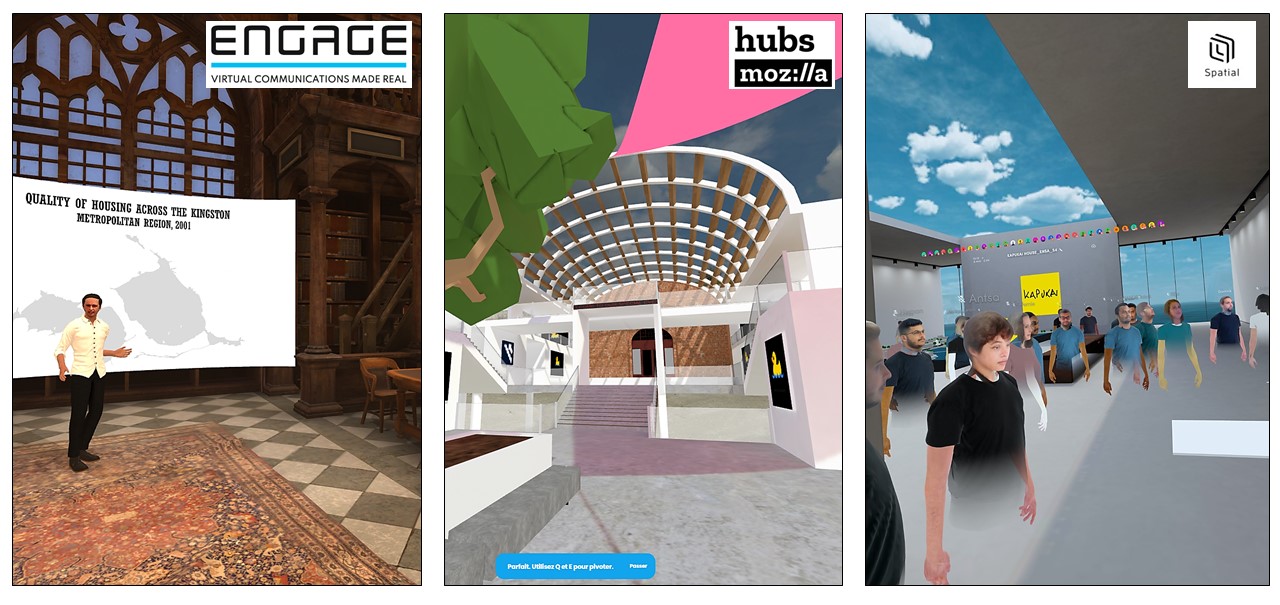 The choice was made based on several criteria that we felt were essential. First of all, the solution had to be suitable for all types of equipment so that the experience could be satisfactory for everyone. Spatial was the only platform at the time that could be experienced with a virtual headset, which was our main objective, a computer that was either Mac or Pc (even if Macs are much less suitable), a tablet or an IOS or Android phone. The richest experience is obtained with VR headsets and we selected the Oculus Quest 2 which is still at this time, the most advantageous solution in its price / performance ratio. The different hardware interfaces all allow you to navigate in virtual space, import content, interact and dialogue with others. The second essential criterion is the ability to transform the environment, adapt it to the needs of the project, import digital models and be able to evaluate them either at reduced scale or at 1:1 scale. Spatial has a function for creating an environment from a 3D model. This means that an FBX, OBJ or GLB file can become the environment in which it is possible to walk around. Some restrictions are still important and penalizing, collisions are not detected, which means that we pass through walls, which also means that we cannot have floors, slopes, in short, for the moment we remain flat. The third essential criterion is the creation of a collective experience. Spatial allows us to receive about fifty visitors in each space, which has allowed us to gather all our groups for beautiful collective presentations. Before entering the virtual world, users are asked to create their avatar. To do this, they must upload a photo that will texture a realistic body. The avatar has some reaction elements, it moves the eyes according to the supposed direction of the gaze, simulates lips when speaking and of course the bars follow the movements of the hands or the controllers when equipped with the headset.
The choice was made based on several criteria that we felt were essential. First of all, the solution had to be suitable for all types of equipment so that the experience could be satisfactory for everyone. Spatial was the only platform at the time that could be experienced with a virtual headset, which was our main objective, a computer that was either Mac or Pc (even if Macs are much less suitable), a tablet or an IOS or Android phone. The richest experience is obtained with VR headsets and we selected the Oculus Quest 2 which is still at this time, the most advantageous solution in its price / performance ratio. The different hardware interfaces all allow you to navigate in virtual space, import content, interact and dialogue with others. The second essential criterion is the ability to transform the environment, adapt it to the needs of the project, import digital models and be able to evaluate them either at reduced scale or at 1:1 scale. Spatial has a function for creating an environment from a 3D model. This means that an FBX, OBJ or GLB file can become the environment in which it is possible to walk around. Some restrictions are still important and penalizing, collisions are not detected, which means that we pass through walls, which also means that we cannot have floors, slopes, in short, for the moment we remain flat. The third essential criterion is the creation of a collective experience. Spatial allows us to receive about fifty visitors in each space, which has allowed us to gather all our groups for beautiful collective presentations. Before entering the virtual world, users are asked to create their avatar. To do this, they must upload a photo that will texture a realistic body. The avatar has some reaction elements, it moves the eyes according to the supposed direction of the gaze, simulates lips when speaking and of course the bars follow the movements of the hands or the controllers when equipped with the headset.
Site Selection and Issues
The German students worked on a Mauritian site, the Mauritians on an American site and the Americans on a German site. The latter had to think about a light, dismountable Rooftop structure, allowing to welcome tourist rentals. The Mauritians focused on the transformation of an existing building in Tallahassee by adding a floor and creating a convivial space. The Americans took on an extension in the city of Hamburg where the question of density is critical due to the impossibility of the city to expand. The idea was to embellish an architecture that was too banal and encourage interaction between students from the different institutions.
Prerequisites and organization
Numerous prerequisites have conditioned the experiment’s success, some of which we anticipated, others of which we have noted over time, sometimes with pain. The first of these prerequisites obviously concerns teachers’ faith in an entirely virtualized environment in which they will have to move around, interact, lead a lesson, and invent new solutions for monitoring and commenting on projects. To accomplish this, we « practiced » with each other for four months at a rate of half a day per week to learn how to draw in space, learn the interactions, load the models, and most importantly, follow the evolutions of a platform that updates very frequently, some of which greatly enhance the user experience.
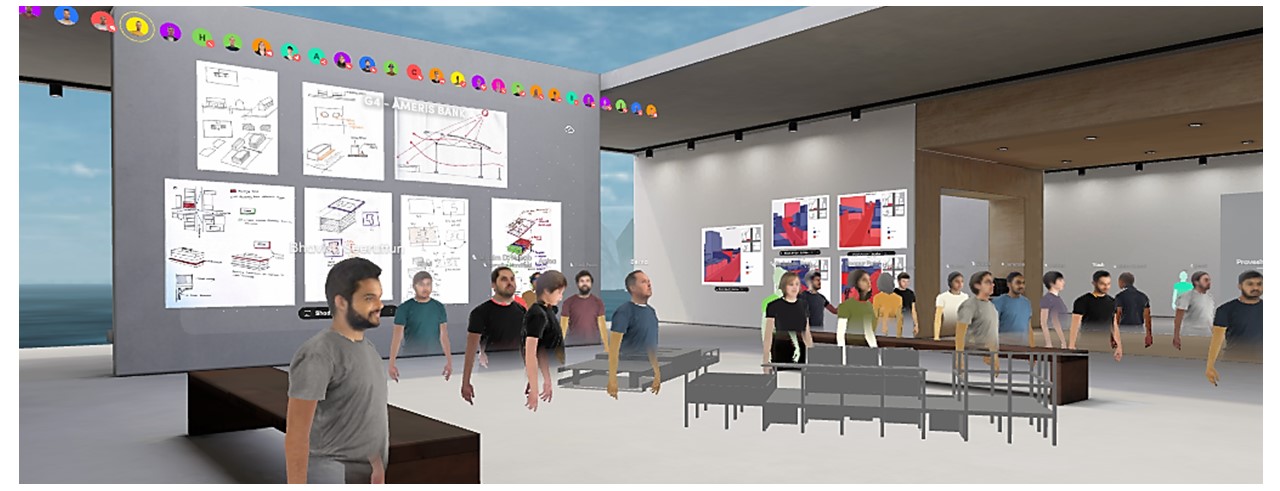 Our primary concern was the students’ internet access. We had no control over the network’s quality because everyone was working from home. If no one could connect, the experience would be unpleasant, exclusionary, and ultimately uninteresting. This would result in the protocol failing. Finally, everyone was able to find enough bandwidth to participate fully.
Our primary concern was the students’ internet access. We had no control over the network’s quality because everyone was working from home. If no one could connect, the experience would be unpleasant, exclusionary, and ultimately uninteresting. This would result in the protocol failing. Finally, everyone was able to find enough bandwidth to participate fully.
Development of the experiment
Obstacles and constraints
Developing a class in a virtual world or on an interactive platform requires some planning and specialized technical knowledge. First and foremost, the file sizes are limited. On Spatial, it is currently limited to 30MB per file, including texture. This means that you cannot send your CAD model to the platform in its current state, as this is unlikely to work. The 30MB limit is still a good one because it allows you to structure your 3D according to zones, themes, or levels of detail. You can separate the floors to be reassembled later, separate the structure from the filling, or even plan a site model that will be seen at a smaller scale.
As previously stated, there are numerous accepted formats; however, some are more appropriate than others. The .glb file extension is recommended. The .glb file extension is a category of 3D file that is commonly used on the internet. It is the binary (compressed) version of glTF, which is another widely used 3D file format on the internet. The abbreviation glb stands for glTF binary. Textures are included in this format. The.fbx format is recommended if animations are desired. Either a skeleton animation or a pointlist animation is required.
The most difficult challenge from an aesthetic standpoint is baking the lights in order to have an illuminated model. Models sent without baking appear bland and sometimes difficult to understand because the platform does not calculate the light. Light baking is the process of calculating and incorporating the shadow and light effects for each face into the texture. When you do this, the model appears to be exposed to light even though no light source is active in the scene. This is a very popular trick in real time, but it requires a high level of technical expertise. This operation is proposed by classic software such as Blender, 3DsMax, Maya, and Cinema4D, but it is tedious and time-consuming. SimLab Composer software (www.simlab-soft.com), on the other hand, does it automatically with real-time optimization. This is the software that we suggest to our students.
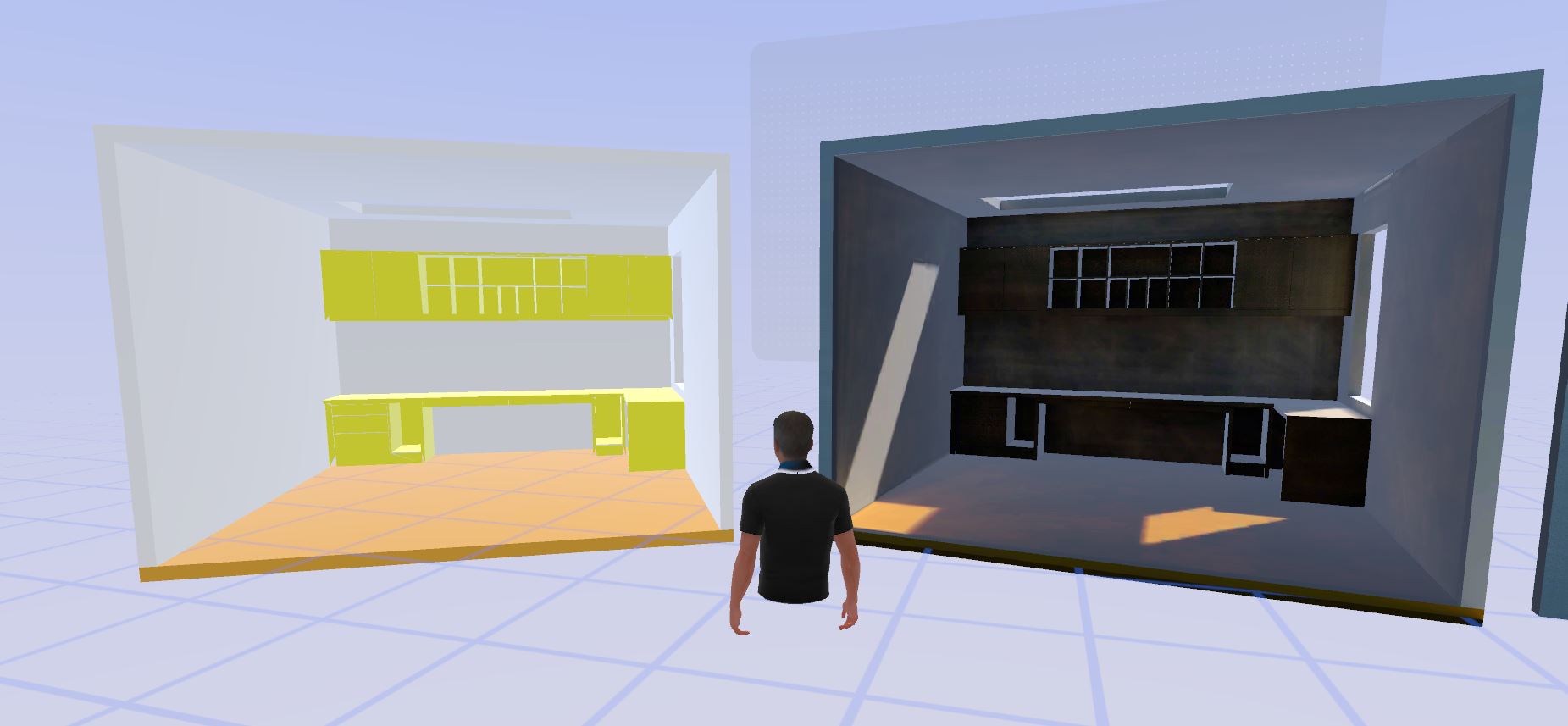 While uploading content to the platform is simple, the visual quality is dependent on expert preparation. It must be integrated into the project’s overall process. This is one of the teaching challenges.
While uploading content to the platform is simple, the visual quality is dependent on expert preparation. It must be integrated into the project’s overall process. This is one of the teaching challenges.
Contributions and revelations
The students recreated virtual studios, giving their virtual projects a real consistency by organizing display areas, presenting models at different scales, and creating the project’s environment in which guests could walk around at 1/1 scale. The project was initially hampered by the poor quality of the hardware, the poor quality of the internet connection, and the poor clarity of the audio. We gradually learned how to calibrate the projects to limit these constraints. The headset experience provided both students and teachers with the project’s interactive, immersive, user-friendly, and innovative dimensions.
Strengths
The use of virtual platforms for the studio brings advantages that mark a real breakthrough.
– Side by side teaching.
Teaching is done side by side here, as teachers and students are immersed in the display, having their avatars standing and navigating one next to another. This kind of teaching is opposed to the traditional studio setting where it is more a face to face configuration.
– Multi-scale models
As scalability is easier to manage in a virtual environment, the students quickly grasped the opportunity to present their proposals at different scales. Site models were presented as if they were laid out on a table, while detail models were displayed as if they were valuable items on a display stand. The buildings could either be presented in a 1:1 scale so that it was possible to enter them or in the form of a reduced scale model, which made it possible to manipulate them to look at them from all aspects.
– Design of the virtual studio
One of the big breakthroughs, and a big surprise, was the design of the virtual environment as a « presentation studio » space for the project, as several students designed a meta environment to showcase their project. This meta environment had thematic concept and aesthetic links to the project’s concept itself without being a replica of it. Once in this process, the students invented solutions so that the presentation of the project became a journey in which they developed a dramaturgy of presentation. We quickly understand that this approach is very rare in real projects, however as an educational approach it enforces the students to take into account the way the project (and presentation space) will be experienced when populated with occupants, issues that are rarely considered due to the lack of tools. The use of VR tools as providers of meta educational space is very inspiring to consider transpositions.
– Collective virtual visit
The problem with virtual reality is that it is an individual experience, using a personal headset and experiencing a specific adventure that is difficult to share. Using the multi-user experience enabled by Spatial platform, what has recently been characterised as the metaverse, enables multiple users to meet and share an experience. The realistic avatars enable users to identify each other easily, discuss, and work. This open and collective world is what makes the experience so interesting; without it, it would remain rather futile.
– Interactive presentation.
In Spatial, interactions with the design project are possible in a different way offered in Reality (or the physical studio). The possibility to write notes, to draw in 2D or 3D, to move objects or to interact with other users enabled the successful workflow of the course. . Difficulties were seen in 3D drawing, limiting the teachers to verbal explanations, accompanied with gestures that served them to point on errors and issues requiring further development. Despite these limitations, the success in meeting the design workflow and desired complexity demonstrates how effective the Spatial platform is to discuss architectural details under an immersive interaction with 3D object.
– Persistent universes
One thing that is especially appreciated and truly different from the real studio is that the worlds are persistent. This means that you can go back days or weeks later and everything is still in place. This is particularly useful for proofreading projects, for presenting to others or for promoting the work of students. Like a website or an address in the real world, all you need is a link to find out where the different spaces are, which can be private or public.
Weaknesses
– 3D skills required
As stated in the prerequisites, the creation of 3D models necessitates strong 3D skills in order to create the geometries for a stunning virtual and real-time experience. To incorporate light, it is necessary to master the number of polygons, texture management, and baking. You must also understand how to create animations, export in the appropriate format for the results you seek, and keep up with tool and platform updates.
– Fast Internet connection
All participants must have access to a high-speed internet connection. We discovered that, despite the platform description, there is a relationship between the number of objects and the number of participants. As a result, we favoured portals and stayed on smaller scenes.
– Low detail models
To ensure real time and the 30MB limit, the models remain low detail. However, strategies can be deployed to fragment the geometries and reassemble them later.
– Best experience with virtual headsets
The biggest weakness is that the experience is only optimal with VR headsets. While it is possible to walk around the spaces with a computer or phone, and it is quite spectacular to be able to view the models in augmented reality, there is nothing that surpasses the virtual tour while being immersed within the projects. Although headsets are now inexpensive, they are not yet part of everyone’s equipment or available in all schools. It should be added that the pandemic circumstances do not help the use of a device that is worn against the face and that could be shared.
Conclusion.
We have introduced the subject of the search for paradigmatic shifts in the design of architectural projects and in particular in the pedagogy of project design. To do this, we postulated that certain uses and certain digital tools could create this shift. To help us identify them, we posed the double concept of narrative of legacy and narrative of emergence which allowed us to filter in the pedagogical curriculum what makes a breach from what remains in the design paradigm as it was proposed before the arrival of digital tools.
Among the narratives of emergence, we experimented with the one concerning real time and immersive design. We based ourselves on an experiment carried out in the context of pandemic locked down, an experiment that brought together three schools from three different continents. This experiment revealed real paradigm shifts, particularly with regard to the experience of the 1:1 project, the interaction within a virtual space and the set of interactions between tutors and students.
However, there is still much to be discovered, as the exploration has only increased the terrain to be mapped. We have thus begun to detect cultural nuances in the management of avatars, for example. This cultural theme will certainly be one of those to which we will pay particular attention in future projects.
References
[1] Wake, W K (2000) Design paradigms: a sourcebook for creative visualization, Wiley
[2] Chastain, T., Kalay, Y. E., & Peri, C. (2002). Square peg in a round hole or horseless carriage? Reflections on the use of computing in architecture. Automation in Construction, 11(2), 237–248. https://doi.org/10.1016/S0926-5805(00)00095-9
[3] Oxman, R. (2008). Digital architecture as a challenge for design pedagogy: theory, knowledge, models and medium. Design Studies, 29(2), 99–120. https://doi.org/10.1016/j.destud.2007.12.003
[4] Egbert, D. D. (1980). The Beaux-Arts Tradition in French Architecture (D. Van Zanten (ed.)). Princeton University Press.
[5] Cuff, D. (1991). Architecture: The Story of Practice. In Contemporary Sociology. MIT Press. https://doi.org/10.2307/2075894
[6] Salama, A. M. (1995). New trends in architectural education. Designing the Design Studio. International Standard Book Numbering.
[7] Knoll, M. (1997). The Project Method: Its Vocational Education Origin and International Development. Journal of Industrial Teacher Education, 34(3), 59–80.
[8] Schön, D. A. (1983). The Reflective Practitioner: How Professionals Think in Action. Basic books.
[9] Schön, D. A. (1985). The design studio : an exploration of its traditions and potentials. RIBA Publications.
[10] Schön, D. A. (1987). Educating the Reflective Practitioner. Toward a new design for teaching and learning in the professions. (first). Jossey-Bass.
[11] Jones, J. C. (1980). Design Methods: seeds of human futures (2nd ed.). John Wiley & Sons.
[12] Salama, A. M. (2015). Spatial Design Education: New Directions for Pedagogy in Architecture and Beyond (Issue May). Routledge. https://doi.org/10.4324/9781315610276
[14] Lescop L., Chamel O (2021). How digital tools are changing architecture education. DCA, Oct 2021, Atlanta, France. ⟨hal-03523003⟩
[15] Benjamin W. (1931). Petite histoire de la photographie, Allia, 2012
[16] Lescop L. (2019). Topologies de l’immersion – Études digitales. Etudes digitales, Classiques Garnier, pp.21-52. ⟨10.15122/isbn.978-2-406-09288-9⟩.
[17] Cruz-Neira, C., Sandin, D., & DeFanti, T. (1993). Surround-Screen Projection-Based Virtual Reality: The Design and Implementation of the CAVE. In JamesT. Kajiya (Ed.), the 20th annual conference on Computer graphics and interactive techniques (pp. 135–142). ACM.
[18] Guelton B. (2014). Les Figures de l’immersion, Les Figures de l’immersion, Rennes : Presses Universitaires de Rennes (pp.9-22)
[18] Sopher, H., & Gero, J. S. (2021). Effect of immersive VR on communication patterns in architectural design critiques. In V. Stojakovic & B. Tepavcevic (Eds.), Towards a new, configurable architecture – Proceedings of the 39th eCAADe Conference. Volume 1 (pp. 123–130).
[20] Sopher, H., Fisher-Gewirtzman, D., & Kalay, Y. E. (2019). Going immersive in a community of learners? Assessment of design processes in a multi‐setting architecture studio. British Journal of Educational Technology, 50(5), 2109–2128. https://doi.org/10.1111/bjet.12857
[21] McCarthy J. (1977) Epistemological problems of artificial intelligence, in IJCAI, 1038-1044
[22] Milovanovic, J., & Gero, J. (2020). MODELING DESIGN STUDIO PEDAGOGY: A MENTORED REFLECTIVE PRACTICE. Proceedings of the Design Society: DESIGN Conference, 1, 1765-1774. doi:10.1017/dsd.2020.118
